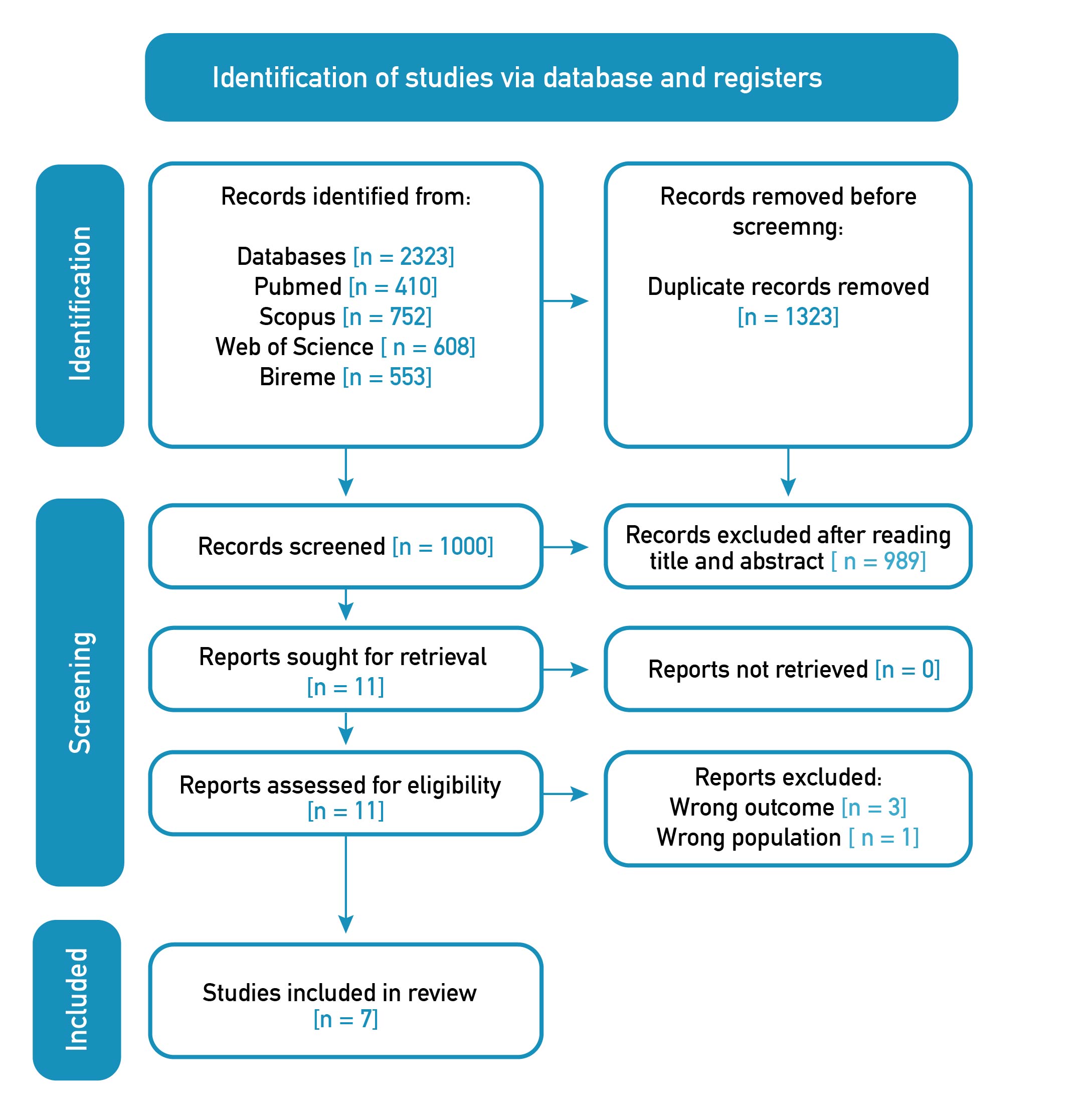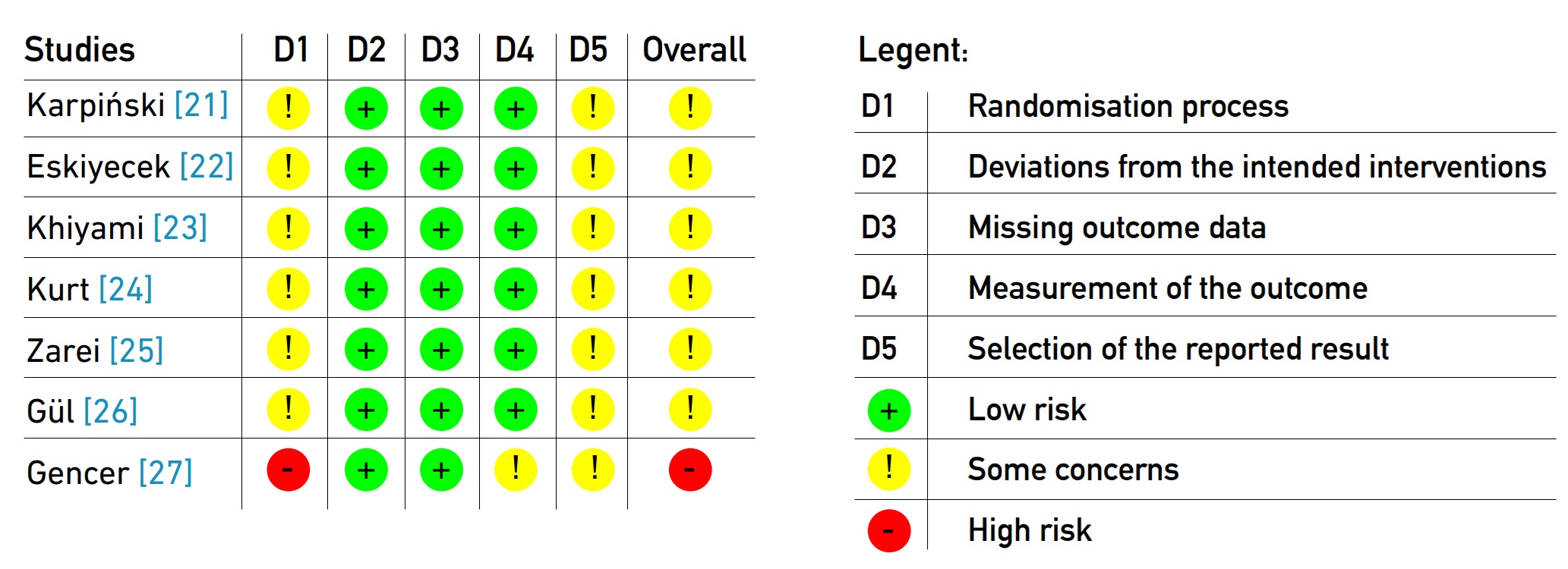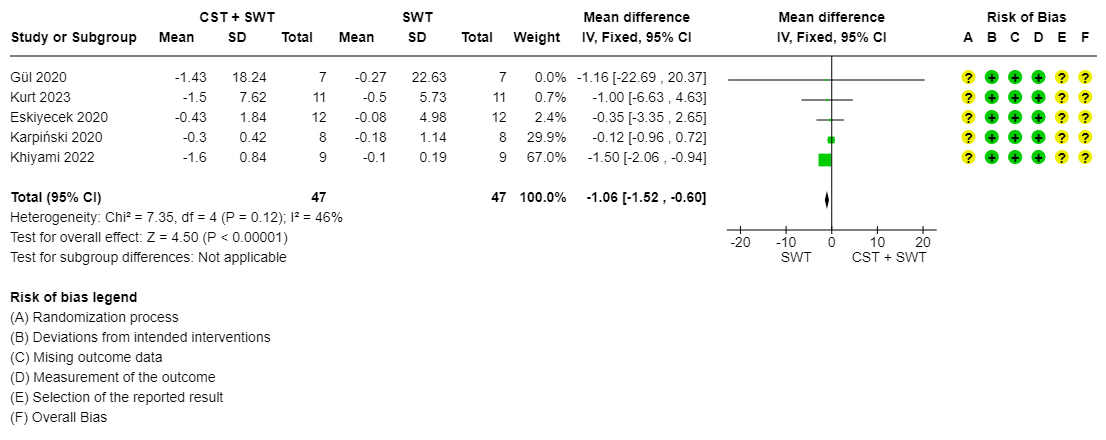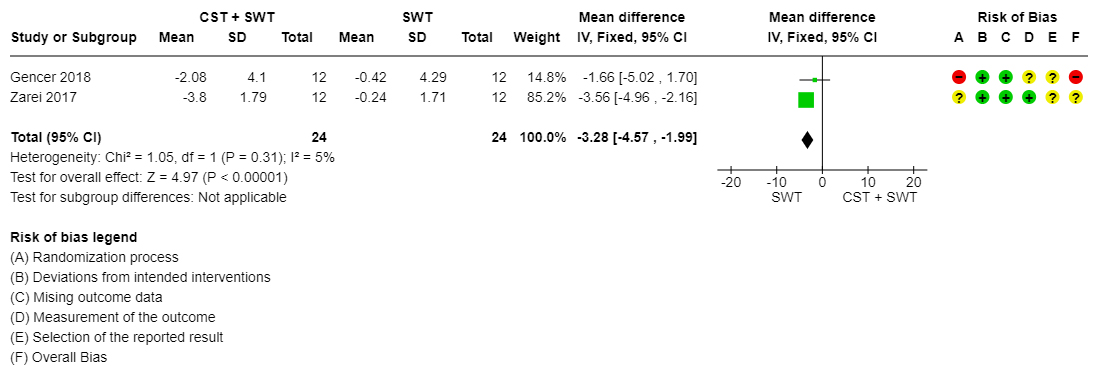Meta-Analysis of the Effects of Core Stability Training on 50-Meter Freestyle Performance in Men and Women
Metanálisis de los efectos del entrenamiento de estabilidad del core en el rendimiento de 50 metros estilo libre en hombres y mujeres
Sebastián Rodríguez , Catalina León-Prieto, María Fernanda Rodríguez Jaime, Alejandra Noguera Peña
Abstract
Introduction. Core stability training (CST) has gained increasing relevance in sports due to its potential to enhance athletic performance and reduce injury risk, particularly in swimming. The 50-meter freestyle is a key performance test in swimming, and understanding the impact of CST on this specific event is essential for optimizing training programs.
Objective. This meta-analysis aimed to evaluate the effects of CST on the performance of male and female swimmers in the 50-meter freestyle.
Methods. A systematic search was conducted in PubMed, Bireme, Scopus, and Web of Science (WOS), adhering to the Cochrane Handbook guidelines. Risk of bias was evaluated using the ROB2 scale, while the quality of the studies was assessed with the SIGN and CONSORT checklists. Data were analyzed using a fixed-effects meta-analysis in RevMan-Web, and heterogeneity was assessed using the 𝐼² and 𝜒² tests.
Results. Out of 2,323 records identified, 7 studies met the inclusion criteria. The meta-analysis revealed that CST significantly improved 50-meter freestyle performance, with a time reduction of -1.06 seconds (95% CI = -1.52, -0.60) in male swimmers and -3.28 seconds (95% CI = -4.57, -1.99) in female swimmers.
Conclusion. CST was found to be effective in enhancing performance in the 50-meter freestyle, particularly in female swimmers. These findings support the use of CST as a valuable training strategy for sports scientists and coaches aiming to improve swimming performance.
Keywords
Abdominal core; core stability; athletic performance; swimmers.
Resumen
Introducción. El entrenamiento de estabilidad del core (CST) ha ganado cada vez más relevancia en los deportes debido a su potencial para mejorar el rendimiento atlético y reducir el riesgo de lesiones, particularmente en natación. Los 50 metros estilo libre son una prueba de rendimiento clave en natación, y comprender el impacto del CST en esta prueba específica es esencial para optimizar los programas de entrenamiento.
Objetivo. Este metanálisis tuvo como objetivo evaluar los efectos del CST en el rendimiento de nadadores masculinos y femeninos en los 50 metros estilo libre.
Métodos. Se realizó una búsqueda sistemática en PubMed, Bireme, Scopus y Web of Science (WOS), siguiendo las pautas del Manual Cochrane. El riesgo de sesgo se evaluó utilizando la escala ROB2, mientras que la calidad de los estudios se evaluó con las listas de verificación SIGN y CONSORT. Los datos se analizaron utilizando un metanálisis de efectos fijos en RevMan-Web, y la heterogeneidad se evaluó utilizando las pruebas 𝐼² y 𝜒².
Resultados. De los 2.323 registros identificados, 7 estudios cumplieron con los criterios de inclusión. El metanálisis reveló que el CST mejoró significativamente el rendimiento en los 50 metros estilo libre, con una reducción de tiempo de -1,06 segundos (IC del 95 % = -1,52, -0,60) en nadadores masculinos y -3,28 segundos (IC del 95 % = -4,57, -1,99) en nadadoras femeninas.
Conclusión. Se descubrió que el CST era eficaz para mejorar el rendimiento en los 50 metros estilo libre, en particular en nadadoras femeninas. Estos hallazgos respaldan el uso del CST como una valiosa estrategia de entrenamiento para los científicos deportivos y los entrenadores que buscan mejorar el rendimiento en la natación.
Palabras clave
Núcleo abdominal; estabilidad del núcleo; rendimiento atlético; nadadores.
Introduction
Core stability training (CST) has gained great importance in sports due to its potential to optimize athletic performance and prevent injuries [1]. Core stability, defined as the ability to maintain postural control and trunk alignment during physical activities [2], is essential in disciplines that demand a high physical level, such as swimming [3]. In particular, the 50-meter freestyle event, one of the most rigorous speed competitions in this sport, requires precise synchronization of movements and efficient transfer of the force generated by the limbs for displacement in the water [4].
The relationship between core stability and 50-meter freestyle performance has been the focus of numerous studies that have explored how the improvement in core stability could be translated into an increase in swimming speed and efficiency [5]. However, the results of these investigations have shown considerable variability, with some studies revealing significant benefits and others reporting non-existent effects [5-8]. This discrepancy in the findings highlights the need for a systematic and comprehensive analysis that integrates the available evidence to provide more robust conclusions.
It should be noted that the only meta-analysis performed on the effect of CST in swimmers also included athletes from other disciplines and healthy adults [9], which could have influenced the interpretation of the results. Furthermore, physiological differences between male and female swimmers, such as body composition, muscle mass distribution, and hormonal effects, suggest that of CST may have differentiated impacts by sex, as well as by the competitive level of the athletes. These variations not only affect how each group engages stabilizing muscles in the water but may also influence the adaptation and effectiveness of CST at different levels of athletic demand [10]. In this context, the present meta-analysis aims to evaluate, through a rigorous quantitative analysis of existing studies, the effects of CST on 50-meter freestyle performance in both male and female swimmers.
Methods
Study design
This meta-analysis was conducted to determine the effects of CST on 50-meter freestyle performance in male and female swimmers. The study was properly registered in the International Prospective Register of Ongoing Systematic Reviews (PROSPERO) under the identification number CRD42024579857. The research was based on the collection and analysis of randomized controlled trials and controlled clinical trials, following the guidelines of the Cochrane Handbook and the statements established by the Preferred Reporting Items for Systematic Reviews and Meta-Analyses (PRISMA) [11,12].
Criteria for the evaluation of studies
Types of studies
Randomized controlled trials and controlled clinical trials, without language restriction, reporting on the effects of CST on 50-meter freestyle performance in male or female swimmers were included.
Type of target population
Studies conducted in swimmers of all ages and sexes who had participated in CST programs, either alone or in combination, were considered. Studies that included athletes from sports modalities other than competitive swimming, those in which the swimmers had underlying pathologies or disabilities, as well as studies that administered ergogenic aids that could influence swimming performance were excluded. Studies with an unclearly defined gender population were also excluded.
Types of intervention
Interventions could include strength, endurance or power exercises aimed at strengthening core musculature or training core stability. Programs could include a variety of exercises performed on stable or unstable surfaces, using body self-loading or external weights. Activities could be dynamic, static or a combination of both.
Types of comparators
Placebo, no training, or any other physical exercise program that did not include core stability exercises nor those aimed at strengthening core musculature with the objective of improving swimming performance, were considered as comparison groups.
Types of outcome measures
The primary outcome measure was 50-meter freestyle performance, evaluated in 25 or 50-meter pools, using handheld digital stopwatches or specialized stopwatches, such as photocells, among others.
Search strategy and procedure
A systematic search was conducted during August 2024, using databases such as PubMed, Scopus, Web of Science and Bireme. The search was optimized using MeSH, DeCS and free terms. Details of the search strategy and history for each of the databases are available in the supplementary material.
Identification of studies and data extraction
Two reviewers made the selection of articles through a preliminary reading of titles and abstracts to determine their relevance. Subsequently, the reviewers independently analyzed the full texts of the pre-selected articles to decide on their inclusion in the review. In case of discrepancies, a third reviewer intervened to resolve the disagreement. The collaborative application Rayyan was used for this process [13]. Data were extracted from each study including title, first author, year of publication, objective, population, methodology, training protocols, and measures or mean differences of the results in the 50-meter freestyle, along with their respective standard deviations. In case of missing data, authors were contacted through the correspondence author's email or through the scientific social network ResearchGate to obtain the missing information.
Quality of the studies
Quality of the included studies was assessed using the clinical trial checklist provided by the Scottish Intercollegiate Guidelines Network (SIGN) [14] and the Consolidated Standards of Reporting Trials (CONSORT) approach [15]. These tools provide predefined criteria for grading quality based on the presentation and reporting of studies. The assessment was performed by two investigators and, in case of disagreement, a third reviewer was involved.
Risk of study bias
Each study was individually assessed for risk of bias using the Risk of Bias 2 (ROB 2) tool of the Cochrane Handbook of Systematic Reviews [16]. The assessment was performed independently by two reviewers, with the intervention of a third reviewer to resolve discrepancies. Although it was considered to perform an analysis of the risk of publication bias using a funnel plot and Egger's test with the t statistic in STATA, it was decided not to carry it out due to the lack of at least 10 studies in each sex, which is the minimum number required to ensure the feasibility of these approaches [17-19].
Statistical analysis
The extracted data were analyzed following the guidelines of the Cochrane Handbook of Systematic Reviews [11]. For the global estimation of effect, means (M) and mean differences (MD) were used, as the measurement units and evaluation methods were consistent across studies. Therefore, it was not necessary to employ the standardized mean difference. Additionally, when needed, the pooled standard deviation (
Results
Study selection
A total of 2,323 articles were identified through the database search. After eliminating duplicates, 1,000 manuscripts remained. Subsequently, they were submitted to a rigorous selection process, first by reviewing titles and abstracts, and then through full-text analysis. Finally, 7 studies were chosen for inclusion in the meta-analysis [21-27] (see Figure 1).
Figure 1. Summary of search and selection of studies.
Characteristics of the included studies
The seven studies analyzed in this review were published between 2017 and 2023, and together included a sample of 142 swimmers, aged between 11 and 20 years. Of these, 71 swimmers were part of the intervention group and 71 of the control group, distributed in 48 females and 94 males. The studies used various dosages and training strategies: five implemented 8-week programs [22,24-27], while two opted for 6-week programs [21,23]. Most investigations established a training frequency of 3 sessions per week [21-23,25,26], although two studies increased the frequency to 4 and 5 sessions per week, respectively [24,27]. Table 1 presents a detailed summary of the most relevant aspects of each included study.
Table 1. Characteristics of the included studies.
| Author | Year | Type of study | Intervention group (CST + SWT) | Control group (SWT) | Core stability training program | ||||
|---|---|---|---|---|---|---|---|---|---|
| # weeks | Frequency | Training surface | Type of exercises | # exercises | |||||
| Gül [26] | 2020 | Randomized clinical trial | n: 7 male swimmers (11.57 ± 1.2 years) | n: 7 male swimmers (11.43 ± 1,2 years) | 8 | 3 times x week | Stable | Does not report | 6 |
| Kurt [24] | 2023 | Randomized clinical trial | n: 11 male swimmers (12-15 years) | n: 11 male swimmers (12-15 years) | 8 | 4 times x week | Stable | Dynamics | 10 |
| Eskiyecek [22] | 2020 | Randomized clinical trial | n: 12 male swimmers (11.25 ± 0.75 years) | n: 12 male swimmers (10.42 ± 0.51 years) | 8 | 3 times x week | Stable | Dynamics | 10 |
| Karpiński [21] | 2020 | Randomized clinical trial | n: 8 male swimmers (20.2 ± 1.17 years) | n: 8 male swimmers (20.0 ± 1.9 years) | 6 | 3 times x week | Stable and e unstable | Dynamics | 4 |
| Khiyami [23] | 2022 | Quasi-experimental clinical trial | n: 9 male swimmers (13 ± 2 years) | n: 9 male swimmers (13.11 ± 2,6 years) | 6 | 3 times x week | Stable | Dynamics and statics | 14 |
| Gencer [27] | 2018 | Quasi-experimental clinical trial | n: 12 female swimmers (10.58 ± 1.31 years) | n: 12 female swimmers (10.75 ± 1.29 years) | 8 | 5 times x week | Stable | Dynamics and statics | 7 |
| Zarei [25] | 2017 | Randomized clinical trial | n 12: female swimmers 12 (14 ±1.08 years) | n: 12 female swimmers (14 ± 1.27 years) | 8 | 3 times X week | Stable | Dynamics | 16 |
Note. Abbreviations = CST: Core stability training; SWT
Quality of the studies
In the assessment of reporting quality using the CONSORT checklist, it was observed that items 2a, 2b, 5, 6a, 6b, 7b, 11b, 12a, 12b, 13a, 13b, 15, 16, 17a, 20, 21 and 22 were fulfilled in all the reviewed studies. Nevertheless, items 1a, 4a, 4b, 8a, 8b, 9, 10, 11a, 23 and 24 were not always adequately reported. The main deficiencies were concentrated in items 8a, 8b, 9, 10 and 11b, which are related to the sample size calculation, the randomization mechanism and the blinding of both participants and evaluators.
Regarding the specific quality of the studies, assessed using the clinical trial checklist proposed by SIGN, six studies were classified as acceptable quality [21-26] and one as low quality [27]. No study complied with item 1.4, referring to blinding of the subjects, investigators, and assessors. Still, it is recognized that given that the intervention in question is physical exercise, implementing the blinding of participants and of the investigators responsible for the training program represents a significant challenge.
Risk of study bias
After applying the ROB 2 tool to assess the risk of bias in the included studies, all of the studies were found to have a low risk of bias in the domains “Deviations from intended interventions” and “Missing outcome data” (see Figure 2). However, concerns and a high risk of bias were identified in the domains “Randomization process” and “Selection of reported outcomes”. Figure 3 presents the detailed individual risk of bias assessment for each of the 7 included studies.
Figure 2. Risk of bias of included studies.
Figure 3. Effect of core stability combined with swimming training vs. swimming training on 50-meter freestyle performance (males).
Note. Forest plot comparing the effect of core stability training combined with swimming training versus swimming training on specific performance in the 50-meter freestyle in male swimmers. Abbreviations= CST: Core stability training. SWT: Swimming training.
Intervention effects on 50-meter freestyle performance
Effects in male swimmers
For the outcome measure in male athletes, five studies were included in the meta-analytic analysis [21-24,26]. The analysis showed low statistical heterogeneity (see Figure 3), with a 𝐼² value of 46% and a 𝜒² of 7.35, which does not exceed degrees of freedom. In addition, the 𝑝 value of 0.12 suggests a possible absence of significant heterogeneity. A mean difference of -1.06 seconds was found in the 50-meter freestyle test (95% CI = -1.52, -0.60), indicating a statistically significant effect in favor of the intervention group (Figure 3).
Effects in female swimmers
For the outcome measure in female athletes, only two studies were included in the meta-analytic analysis [25,27]. The analysis showed low statistical heterogeneity (see Figure 4), with a 𝐼² value of 5% and a 𝜒² of 1.05, which exceeds the degrees of freedom by 50%. Additionally, the 𝑝 value of 0.31 suggests a possible absence of significant heterogeneity. A mean difference of -3.28 seconds was found in the 50-meter freestyle test (95% CI = -4.57, -1.99), indicating a statistically significant effect in favor of the intervention group (Figure 4).
Figure 4. Effect of core stability combined with swimming training vs. swimming training on 50-meter freestyle performance (females).
Note. Forest plot comparing the effect of core stability training combined with swimming training versus swimming training on specific performance in the 50-meter freestyle in female swimmers. Abbreviations= CST: Core stability training. SWT: Swimming training.
Discussion
This systematic review with meta-analysis is presented as a pioneer in investigating the effects of core stability training (CST) on 50-meter freestyle performance, being to our knowledge the first of its kind. Previous reviews have focused on the effects of CST on general physical tests, such as jumping, running speed or CORE and limb strength [28,29]. However, specific performance in sport tests had been studied mainly in throwing sports such as baseball, although with a remarkable heterogeneity among studies, which could overestimate the real value of the results. Furthermore, in specific speed tests in various sports, the meta-analysis by Saeterbakken et al. [9] reported a significant improvement, with a reduction of 0.66 units in the standard deviation of the standardized mean difference (95% CI = 0.20, 1.12) in speed performance, including a study on swimming speed. In that meta-analysis, the standardized mean difference was used due to variations in measurements among the included studies, unlike the present meta-analysis, which used the mean difference. According to Cohen's criteria, this is a medium-sized effect [30]. Although the clinical relevance of these findings may seem modest, even small improvements can be crucial in the sports context.
From a theoretical perspective, these findings can be understood from different approaches. Core strength and stability are key to ensuring adequate force transmission from the large structures of the body, such as the trunk to the limbs. Even if the limbs possess great strength, if the core is not stable, that force transfer is impaired, leading to less force production in the peripheral segments and less efficient movement patterns [31]. Besides, according to the kinetic chain theory, any interruption in this muscle sequence can lead to energy losses, which has a negative impact on the execution of complex movements that require high physical performance [32]. These losses can originate both from a lack of stability and from muscle fatigue, which prevents the establishment of a solid base for a correct transmission of force.
This approach is supported by the study of Rosemeyer et al. [33], which evidenced how fatigue in the core musculature decreases the ability to generate force in the limbs, affecting their performance in all planes of motion. Moreover, it has been shown that a well-conditioned core musculature is closely linked to better performance in activities such as running and force or power generation [34].
Strengths and limitations of the study
This study represents the first systematic review with meta-analysis investigating the effects of CST on the specific performance of swimmers, positioning itself as a pioneering work in this field. Among the main strengths of the study, the methodical approach used in the search and selection of the studies, as well as in the data extraction and evaluation of the risk of bias, quality of the reports and quality of the included studies stand out. No studies were excluded by language or year of publication, which ensured the inclusion of all available evidence. In addition, the fact that at least two reviewers were involved in the initial phases of the search, selection, extraction and evaluation of the studies helped to reduce bias and improve the quality of the process.
Nevertheless, there are some important limitations, particularly related to the risk of bias in the considered studies. One of the studies showed a high risk of bias [27], while the others presented some concerns [21-26], mainly due to the lack of trial registration and lack of clarity in the report on the concealment of the randomization sequence, which generates some uncertainties. On the other hand, it is important to note that six out of the seven included studies analyzed a population of athletes aged 10 to 13 years [21-27]. This age range corresponds to a critical stage of biological and hormonal maturation, which can significantly impact physical performance [35,36], potentially leading to an over- or underestimation of the intervention's true effect. Additionally, the studied population consisted exclusively of semi-professional level swimmers. This suggests that the findings may not be generalizable to other groups of swimmers, such as amateurs, who might benefit more substantially from this type of training, or elite-level swimmers, whose highly developed physical characteristics could result in a more modest response.
Another relevant limitation is the underrepresentation of female swimmers in the sample; only two studies included female participants [25,27]. This imbalance could result in an overestimation of the effect observed in this group. The limited data on female athletes weakens the robustness of conclusions regarding their response to the intervention, highlighting the need for greater inclusion of female samples in future studies. Given these limitations, we recommend that future researchers conduct additional primary studies involving both amateur and professional swimmers, as well as address the significant gap in data on female populations. This approach will allow for more accurate conclusions and a more balanced representation of responses to the intervention across diverse populations. Finally, although meta-analysis allows combining studies and increasing statistical power by including a larger number of subjects, which would not be possible in individual studies, the total population in this meta-analysis remains relatively small. Still, without this synthesis, the number of participants would be even more limited.
Conclusion
In the first place, these findings highlight the importance of future studies registering their protocols in advance on platforms such as ClinicalTrials [37], ensuring a more rigorous approach. In addition, it is crucial that investigators ensure and report in detail the randomization sequence and to the extent possible, attempt to blind evaluators, recognizing that due to the nature of the training, blinding the participants and trainers can be complicated.
In the second place, these results have practical implications for swimming coaches, who can integrate core stability training (CST) not only as a tool in physical therapy for injury prevention and rehabilitation of low back problems [38], but also as an effective strategy to optimize the physical performance of the athletes.
Finally, it is concluded that CST was shown to be effective in improving performance in the 50-meter freestyle test, reducing the time by -1.06 seconds (95% CI = -1.52, -0.60) in male swimmers and by -3.28 seconds (95% CI = -4.57, -1.99) in female swimmers. These results suggest that sport scientists working with swimmers might consider this type of training as a valuable tool to improve performance and help the athletes to achieve their sporting goals.
References
1. Okada T, Huxel KC, Nesser TW. Relationship between core stability, functional movement, and performance. J Strength Cond Res [Internet]. 2011;25(1):252-61. doi: http://dx.doi.org/10.1519/JSC.0b013e3181b22b3e
2. Jia X, Jiang C, Tao J, Li Y, Zhou Y, Chen LD. Effects of core strength training combined with Tai Chi Chuan for the musculoskeletal system and cardiopulmonary function in older adults: A study protocol for a randomized controlled trial. Medicine (Baltimore) [Internet]. 2018;97(35):e12024. doi: https://doi.org/10.1097/MD.0000000000012024
3. Zemková E, Zapletalová L. The role of neuromuscular control of postural and core stability in functional movement and athlete performance. Front Physiol [Internet]. 2022;13:796097. doi: http://dx.doi.org/10.3389/fphys.2022.796097
4. Đurović M, Vranešić-Hadžimehmedović D, Paunović M, Madić D, Okičić T. A comparison of race performance characteristics between elite male 50-m and 100-m freestyle swimmers based on their results. Facta Univ Ser Phys Educ Sport [Internet]. 2020;17(3):453-62. doi: http://dx.doi.org/10.22190/fupes191107040d
5. Patil D, Salian SC, Yardi S. The effect of core strengthening on performance of young competitive swimmers. International Journal of Science and Research [Internet]. 2014;3(6):2470-7. Available from: https://www.ijsr.net/getabstract.php?paperid=2014789
6. Weston M, Hibbs AE, Thompson KG, Spears IR. Isolated core training improves sprint performance in national-level junior swimmers. Int J Sports Physiol Perform [Internet]. 2015;10(2):204-10. doi: http://dx.doi.org/10.1123/ijspp.2013-0488
7. Sawdon-Bea J, Benson J. The effects of a 6-week dry land exercise program for high school swimmers. J Phys Educ Sports Manag [Internet]. 2015;2(1):1-17. Available from: https://jpesm.thebrpi.org/vol-2-no-1-june-2015-abstract-1-jpesm
8. Darchini M, Darzabi T, Mofrad Moghadam MM, Nabavinik M. The Effect of a 6-Week Core Stability Training Program on the Stroke Index and Front Crawl Record of Male Swimmers. Journal of sport biomechanics [Internet]. 2019;5(2):124-33. doi: https://doi.org/10.32598/biomechanics.5.2.6
9. Saeterbakken AH, Stien N, Andersen V, Scott S, Cumming KT, Behm DG, et al. The effects of trunk muscle training on physical fitness and sport-specific performance in young and adult athletes: A systematic review and meta-analysis. Sports Med [Internet]. 2022;52(7):1599-622. doi: http://dx.doi.org/10.1007/s40279-021-01637-0
10. Thibault V, Guillaume M, Berthelot G, Helou NE, Schaal K, Quinquis L, et al. Women and Men in Sport Performance: The Gender Gap has not Evolved since 1983. J Sports Sci Med [Internet]. 2010;9(2):214-23. Available from: https://pubmed.ncbi.nlm.nih.gov/24149688/
11. Higgins JPT, Thomas J, editors. Cochrane handbook for systematic reviews of interventions. 2nd ed. Hoboken: Willey Blackwell; 2019. 736 p.
12. Ardern CL, Büttner F, Andrade R, Weir A, Ashe MC, Holden S, et al. Implementing the 27 PRISMA 2020 statement items for systematic reviews in the sport and exercise medicine, musculoskeletal rehabilitation and sports science fields: the PERSiST (implementing Prisma in exercise, rehabilitation, sport medicine and SporTs science) guidance. Br J Sports Med [Internet]. 2022;56(4):175-95. doi: https://doi.org/10.1136/bjsports-2021-103987
13. Ouzzani M, Hammady H, Fedorowicz Z, Elmagarmid A. Rayyan-a web and mobile app for systematic reviews. Syst rev [Internet]. 2016;5. doi: http://dx.doi.org/10.1186/s13643-016-0384-4
14. The Scottish Intercollegiate Guidelines Network (SIGN). SIGN makes sense of evidence [Internet]. Edinburgh: Healthcare Improvement Scotland; c2023 [updated 2023]; [about 2 screens]. Available from: https://www.sign.ac.uk/
15. Cuschieri S. The CONSORT statement. Saudi j anaesth [Internet]. 2019;13(Suppl 1):S27-30. doi: http://dx.doi.org/10.4103/sja.SJA_559_18
16. Sterne JAC, Savović J, Page MJ, Elbers RG, Blencowe NS, Boutron I, et al. RoB 2: a revised tool for assessing risk of bias in randomised trials. BMJ [Internet]. 2019;366:l4898. doi: http://dx.doi.org/10.1136/bmj.l4898
17. Godavitarne C, Robertson A, Ricketts DM, Rogers BA. Understanding and interpreting funnel plots for the clinician. Br J Hosp Med [Internet]. 2018;79(10):578-83. doi: https://doi.org/10.12968/hmed.2018.79.10.578
18. Sterne JA, Sutton AJ, Ioannidis JPA, Terrin N, Jones DR, Lau J, et al. Recommendations for examining and interpreting funnel plot asymmetry in meta-analyses of randomised controlled trials. BMJ [Internet]. 2011;343:d4002. doi: https://doi.org/10.1136/bmj.d4002
19. Mavridis D, Salanti G. How to assess publication bias: funnel plot, trim-and-fill method and selection models. Evid Based Ment Health [Internet]. 2014;17(1):30. doi: https://doi.org/10.1136/eb-2013-101699
20. Melsen WG, Bootsma MCJ, Rovers MM, Bonten MJM. The effects of clinical and statistical heterogeneity on the predictive values of results from meta-analyses. Clin Microbiol Infect [Internet]. 2014;20(2):123-9. doi: http://dx.doi.org/10.1111/1469-0691.12494
21. Karpiński J, Rejdych W, Brzozowska D, Gołaś A, Sadowski W, Swinarew AS, et al. The effects of a 6-week core exercises on swimming performance of national level swimmers. PLoS One [Internet]. 2020;15(8):e0227394. doi: http://dx.doi.org/10.1371/journal.pone.0227394
22. Eskiyecek CG, Gül M, Uludağ B, Gül GK. The Effect of 8-Week Core Exercises Applied to 10-12 Age Male Swimmers on Swimming Performance. International journal of applied exercise physiology [Internet]. 2020;9(3):213-20. Available from: https://www.proquest.com/openview/509977b6b531cf84df23f82f042ab990/1?pq-origsite=gscholar&cbl=2045597
23. Khiyami A, Nuhmani S, Joseph R, Abualait TS, Muaidi Q. Efficacy of core training in swimming performance and neuromuscular parameters of young swimmers: A randomised control trial. J Clin Med [Internet]. 2022;11(11):1-13. doi: http://dx.doi.org/10.3390/jcm11113198
24. Kurt S, Ibis S, Aktug ZB, Altundag E. The Effect of Core Training on Swimmers’ Functional Movement Screen Scores and Sport Performances. JTRM Kinesiol. 2023;9:1-6. Available from: https://files.eric.ed.gov/fulltext/EJ1367802.pdf
25. Zarei M, Hovanloo F, Ramin N. The Effect of core stability exercises with Swiss ball on the performance of sub-elite adolescent swimmers. Studies in Sport Medicine [Internet]. 2019;10(24):17-28. doi: https://doi.org/10.22089/smj.2017.4397.1256
26. Gül M, Alagöz İ, Gül GK. Effect of core stabilization training applied to 10-13 age swimmers on the swimming time and some motoric characteristics. European Journal of Physical Education and Sport Science [Internet]. 2020;6(1):12-24. doi: http://doi.org/10.5281/zenodo.3612765
27. Gencer YG. Effects of 8-week core exercises on free style swimming performance of female swimmers aged 9-12. Asian j educ train [Internet]. 2018;4(3):182-5. doi: http://dx.doi.org/10.20448/journal.522.2018.43.182.185
28. Rodríguez-Perea Á, Reyes-Ferrada W, Jerez-Mayorga D, Chirosa Ríos L, Van den Tillar R, Chirosa Ríos I, et al. Core training and performance: a systematic review with meta-analysis. Biol Sport [Internet]. 2023;40(4):975-92. doi: http://dx.doi.org/10.5114/biolsport.2023.123319
29. Rodríguez S. Efectos del entrenamiento de estabilidad central sobre el rendimiento físico: una revisión de la literatura. Cuestiones de fisioterapia: revista universitaria de información e investigación en Fisioterapia. 2023;52(3):272-81.
30. Cohen J. Statistical power analysis for rhe behavioral sciences. 2nd ed. Hillsdale: Lawrence Erlbaum; 1988. 567 p.
31. Sharrock C, Cropper J, Mostad J, Johnson M, Malone T. A pilot study of core stability and athletic performance: is there a relationship? Int J Sports Phys Ther [Internet]. 2011;6(2):63-74. Available from: https://pubmed.ncbi.nlm.nih.gov/21713228/
32. Silfies SP, Ebaugh D, Pontillo M, Butowicz CM. Critical review of the impact of core stability on upper extremity athletic injury and performance. Braz J Phys Ther [Internet]. 2015;19(5):360-8. doi: http://dx.doi.org/10.1590/bjpt-rbf.2014.0108
33. Rosemeyer JR, Hayes BT, Switzler CL, Hicks-Little CA. Effects of core-musculature fatigue on maximal shoulder strength. J Sport Rehabil [Internet]. 2015;24(4):384-90. doi: http://dx.doi.org/10.1123/jsr.2014-0216
34. Santos MS, Behm DG, Barbado D, DeSantana JM, Da Silva-Grigoletto ME. Core endurance relationships with athletic and functional performance in inactive people. Front Physiol [Internet]. 2019;10:1490. doi: http://dx.doi.org/10.3389/fphys.2019.01490
35. Prommer N, Wachsmuth N, Thieme I, Wachsmuth C, Mancera-Soto EM, Hohmann A, et al. Influence of endurance training during childhood on total hemoglobin mass. Front Physiol [Internet]. 2018;9:251. doi: http://dx.doi.org/10.3389/fphys.2018.00251
36. Mancera-Soto E, Ramos-Caballero DM, Magalhaes J, Chaves Gomez S, Schmidt WFJ, Cristancho-Mejía E. Quantification of testosterone-dependent erythropoiesis during male puberty. Exp Physiol [Internet]. 2021;106(7):1470-81. doi: http://dx.doi.org/10.1113/EP089433
37. Zarin DA, Tse T, Williams RJ, Califf RM, Ide NC. The ClinicalTrials. gov results database-update and key issues. N Engl J Med [Internet]. 2011;364(9):852-60. doi: https://doi.org/10.1056/NEJMsa1012065
38. Huxel Bliven KC, Anderson BE. Core stability training for injury prevention. Sports Health [Internet]. 2013;5(6):514-22. doi: http://dx.doi.org/10.1177/1941738113481200




